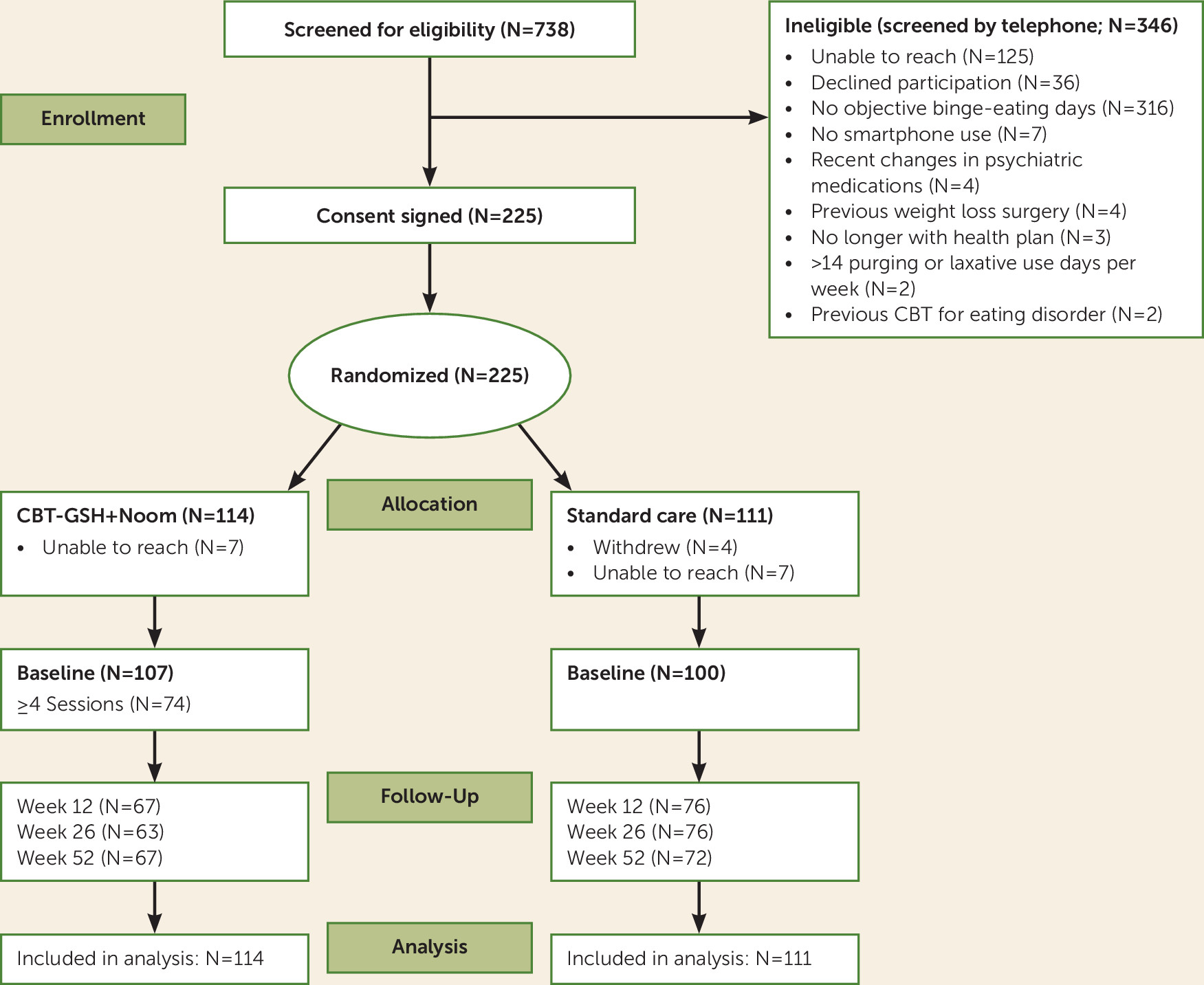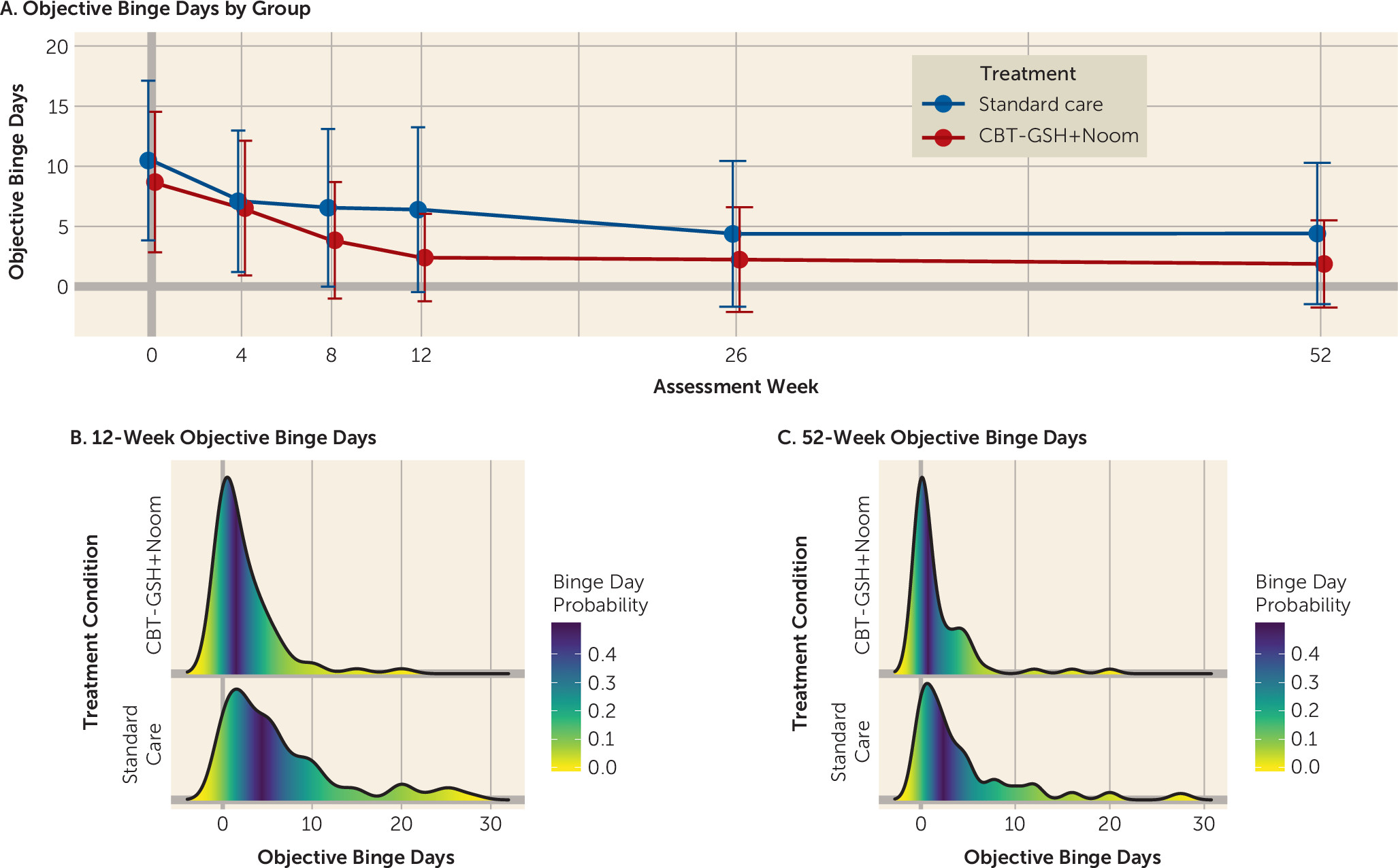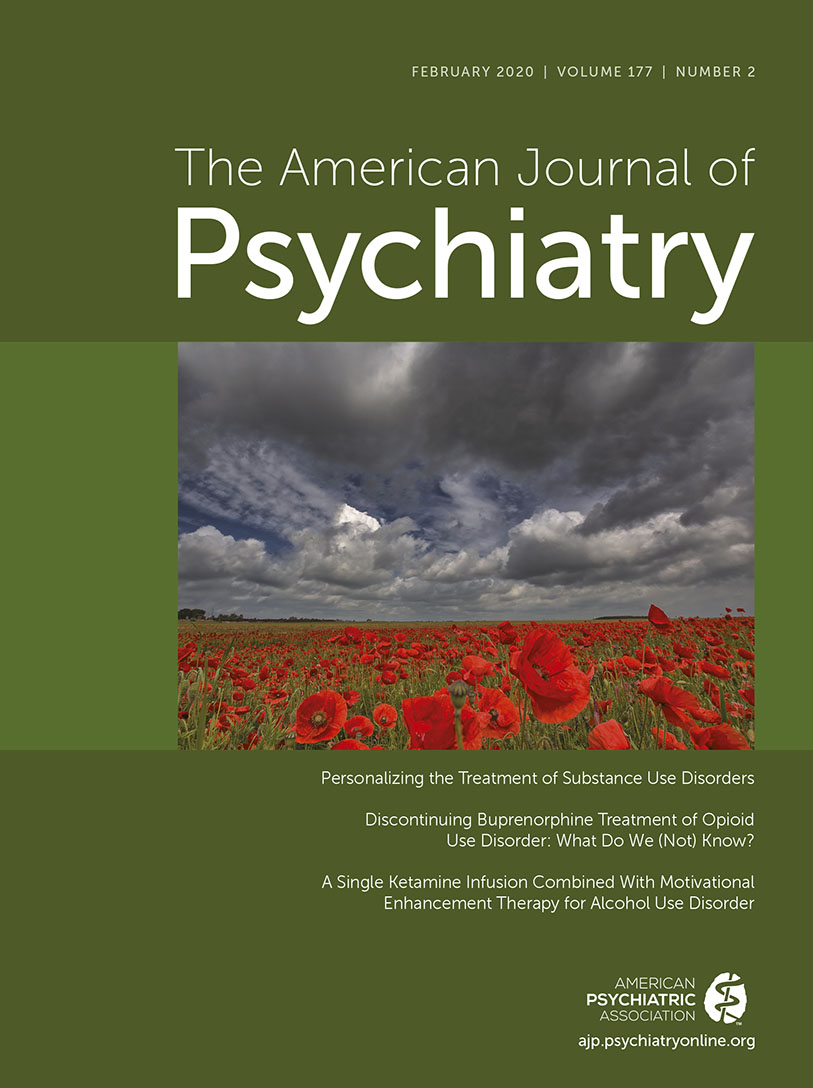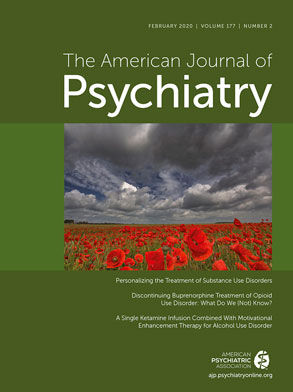Psychiatric disorders characterized by binge eating (including binge-eating disorder and bulimia nervosa) and defined by consumption of an objectively large amount of food accompanied by a sense of loss of control (
1) affect approximately 2%−4% of the U.S. population (
2). Cognitive-behavioral therapy (CBT) has demonstrated efficacy in individual, group, guided self-help (GSH), and pure self-help interventions (
3) that have recently migrated into technology-delivered or technology-assisted formats (e.g., Internet, smartphone app, and software) (
4). Evidence of efficacy of these technological adaptations is emerging but limited (
5,
6). Cost-effectiveness estimates (
7) of these interventions favor lower-intensity technology-based interventions over face-to-face methods, despite direct comparisons favoring face-to-face interventions in the short term (
8).
Given the limited availability of therapists trained in administering CBT-GSH and, even when available, the potential barrier of attending in-person sessions consistently, digital treatment platforms may offer a preferred and more accessible treatment option. In addition, such platforms allow for scalability, and the more flexible remote delivery may result in better adherence, thereby leading to more robust improvement (
6,
9,
10). Therapist-assisted forms of Internet CBT have demonstrated efficacy (
11) and yield greater satisfaction over purely digital CBT interventions, even when treatment response is similar (
12). Mobile technologies are increasingly available and popular among patients (
13) and clinicians (
14), and there is evidence that text messaging can help improve adherence to and retention in treatments involving such platforms (
15–
17). In our previous pilot study, the Noom Monitor, a smartphone app developed to facilitate CBT-GSH, was acceptable to patients, was feasible to deliver, and demonstrated effects similar to those of a traditional paper-and-pencil GSH format over a 6-month follow-up period (
18). In addition, CBT-GSH plus Noom Monitor yielded significantly greater reductions in binge episodes and greater adherence to regular eating (meal and snack adherence), as well as a number needed to treat of 4.5 for end-of-treatment differences. These differences did not persist through the 6-month follow-up, because participants in the traditional CBT-GSH group had a significant increase in remission from the 3- to 6-month follow-up assessments, whereas participants in the CBT-GSH plus Noom Monitor group reported a stable rate of reduction in binge episodes between posttreatment and 9-month follow-up assessments.
In the present study, we extended our pilot study by evaluating the robustness of the intervention when delivered by interventionists who were not experts in treatment for eating disorders in an everyday clinical practice setting, comparing the effectiveness of standard care and CBT-GSH plus Noom Monitor delivered using telephone coaching. The study was conducted in the real-world health care delivery setting of Kaiser Permanente Northwest, with health coaches trained in CBT-GSH (
19). Our primary hypothesis was that CBT-GSH plus Noom Monitor delivered by telephone would lead to greater reductions in eating disorder symptoms at 12 weeks (end of treatment) and the 9-month follow-up (52 weeks after randomization). Our implementation goal and hypothesized effect were a direct extension of the symptom improvements demonstrated in our pilot study (
18) and an effort to determine whether nonspecialist coaches could deliver this intervention in a community health care system via telemedicine.
Results
The baseline demographic and clinical characteristics of the study participants are summarized in
Table 1. The baseline differences between the two study groups suggest no significant effect on randomization (i.e., randomization was not confounded). The total sample (N=225) was predominantly female (75.1%, N=169) and Caucasian (83.6%, N=188). Five percent (N=11) were Asian, 4.4% (N=10) were African American, and 7.6% (N=17) self-reported as other. Eight percent (N=19) identified as Hispanic or Latino. The majority of participants were high school graduates (32.9%, N=74), and 10.7% (N=24) had less than a high school education. Most participants were married (65.8%, N=148), and 9.3% (N=21) were living with a partner. The remaining participants reported being single, divorced, or widowed. The majority of participants (75.1%, N=169) reported an annual household income >$50,000. The mean BMI was 31.67 (SD=4.58; range, 20.39–39.72), and 33% of participants (N=75) endorsed at least one compensatory behavior (vomiting, use of laxatives, and excessive exercise) in the past month.
Primary Outcomes
Change in objective binge-eating days is presented in
Figure 2, and model-estimated treatment effects are summarized in
Table 2. Participants in the CBT-GSH plus Noom Monitor group reported significantly greater change in objective binge days (β=–0.66, 95% CI=–1.06, –0.25; Cohen’s d=−1.46, 95% CI=–4.63, –1.09) at the 52-week assessment, as well as higher remission rates (56.7% [38/67] compared with 30% [12/40]; number needed to treat=3.74). If we classify all missing data as treatment failures, the ratios of remission rates are similar (33.3% [33/114] compared with 10.8% [12/111]; number needed to treat=4.1). Raw means and standard deviations, reported in Table S1 in the
online supplement, reveal that week-12 (end of intervention period) averages were 3.79 objective binge days per month for the CBT-GSH plus Noom Monitor group and 2.63 days per month for the standard care group. In addition, the CBT-GSH plus Noom group achieved a higher remission rate at the end of the intervention period compared with the standard care group (41.8% [28/67] compared with 16.1% [16/87]). Compensatory behaviors (vomiting, use of laxatives, and excessive exercise) were reduced in the CBT-GSH plus Noom Monitor group (rate of remission, 76.3% [29/38] compared with the standard care group (rate of remission, 56.8% [21/37]; number needed to treat=5.11).
Sensitivity analyses were used to estimate treatment effects for participants with complete data (“completers”) and under the not-missing-at-random assumption. Pattern-mixture modeling of objective binge days revealed a larger treatment effect on objective binge days (β=−0.83, 95% CI=−1.15, −0.32; Cohen’s d=−1.85, 95% CI=−5.28, −1.46) and on remission rates (β=1.87, 95% CI=0.43, 3.30; Cohen’s d=2.66, 95% CI=1.20, 9.24). Completer analysis revealed larger effects of treatment on objective binge days (β=−1.05, 95% CI=−1.79, −0.28; Cohen’s d=−1.80, 95% CI=−6.12, −0.95), but the effect on remission rates was less precise (β=1.10, 95% CI=−0.80, 2.99; Cohen’s d=1.58, 95% CI=−2.24, 8.42). A total of 64.9% (N=74/114) of participants in the CBT-GSH plus Noom Monitor group completed at least four coach-delivered sessions in the first 4 weeks, and 38.6% (N=44/114) completed all eight sessions.
Secondary Outcomes
Treatment effects on secondary outcomes are summarized in
Table 3. Across secondary measures, CBT-GSH plus Noom Monitor was superior to standard care, and effect sizes (Cohen’s d) ranged from −1.14 to −2.75, with the largest effect size found for reduction in clinical impairment related to eating pathology. There was no statistically significant difference in quality of life between the two groups at 52 weeks, although there was significantly greater improvement at week 12 (β=4.64, SE=1.64, 95% CI=1.42, 7.86; Cohen’s d=0.82, 95% CI=0.48, 2.71), but this change did not persist into the follow-up period.
Predictors and Moderators of Outcome
Predictors of change for primary and secondary outcomes are summarized in
Table 4. Married participants reported higher rates of remission from binge eating compared with nonmarried participants (39.62% [42/108] compared with 26.67% [16/60]), as well as greater improvement in concerns about body shape, weight, and eating. Higher annual household income was significantly associated with less improvement in clinical impairment and depression. Men reported greater reductions in clinical impairment, but no other significant sex differences were observed. Race and education were not significant predictors of outcomes. General moderators indicated two significant interactions (
Table 5), suggesting that CBT-GSH plus Noom Monitor had a significantly greater effect on eating concerns and quality of life among different demographic and clinical profiles of participants. Higher composite score-by-treatment interaction was associated with greater improvements in quality of life among participants receiving CBT-GSH plus Noom Monitor who reported higher income, education, and being married. Improvements regarding eating concerns were greater for individuals who identified as white and non-Hispanic and had a higher BMI. For interpretation of composite profiles, we followed recommendations by Kraemer et al. (
24), and factor loadings for the composite variable are presented in Table S2 in the
online supplement.
Discussion
The results of this trial indicate that CBT-GSH plus Noom Monitor, delivered via telemedicine by routine-practice health coaches and embedded within a commercial health care system, was superior to standard care (control arm), which included no eating disorder treatment (treatment as usual) during the intervention period (baseline through week 12), for improvement of primary eating disorder symptoms, related impairment in functioning, and associated depressive symptoms. CBT-GSH plus Noom Monitor generated one additional responder per four patients treated for binge-eating disorder and bulimia nervosa, respectively (number needed to treat=3.74), with approximately 57% of participants reporting remission at week 52 and changes in secondary symptoms reflecting a similar level of improvement. The remission rate increased beyond the intervention period, even though average objective binge-eating days remained stable, suggesting that the effects of the intervention continued to facilitate changes during the posttreatment follow-up period (weeks 12 through 52) that were not observed among participants who received standard care. Although the coaches ended the intervention at week 12, participants had access to the self-help manual and Noom Monitor app beyond the coaching period and were encouraged to continue using the program until they achieved remission. These results are similar to those of our pilot study with Noom Monitor, conducted within a specialty clinic with face-to-face sessions with a therapist experienced in the treatment of eating disorders (
18), suggesting that the effects are transferable to telemedicine and into a broader commercial-care setting facilitated by routine-practice health coaches.
In previous studies of CBT-GSH and/or pure self-help conducted in commercial or primary care settings, remission rates of 30%−40% have been reported as well as Cohen’s d values in the range of 0.4–1.2 (
26–
29). In the present study, participants assigned to CBT-GSH plus Noom Monitor reported a remission rate of 39.62% and symptom changes of one to two standard deviations more than the control condition (Cohen’s d range, −1.07 to −2.15). Digital interventions have proven efficacious (
30,
31), with meta-analyses suggesting that technology-driven self-help interventions are similar to other active self-help interventions (
32). The adaptation of the guided self-help model to a mobile platform has support for other mental health conditions (
33,
34) and is likely to play a significant role in the evolution of mental health services (
35). This study extends these findings to adults with broadly defined symptoms of binge eating and compensatory behavior, suggesting that robust changes are possible through this type of intervention.
Several predictors of treatment outcome were identified in our study. The presence of a marital partner resulted in better outcomes, which is consistent with promising results from couples-focused interventions for binge eating (
36). The greater reduction in clinical impairment among men is difficult to interpret, because their symptom reductions were similar to those observed for women. Participants with lower household income experienced greater reduction in depressive symptoms and clinical impairment, which suggests that CBT-GSH may have benefits for individuals with greater obstacles to expert care (i.e., transportation, childcare, etc.).
There were two significant composite moderator effects of treatment response, but no single moderator, which is consistent with findings for CBT more broadly for binge eating (
37). Examination of the composite profiles suggested that participants who had higher income and education and who were married experienced greater quality-of-life improvements. Participants who identified as white non-Hispanic and had a higher BMI reported greater improvements in eating concerns. Eating concerns, as measured by the Eating Disorder Examination Questionnaire, relate to guilt and social anxiety about eating. These findings should be interpreted with caution, because the study was not primarily powered to examine moderators, and the findings could reflect type I errors.
The effects of CBT-GSH have clear evidence of cost savings (
38), and adaptation to smartphone technology offers an important tool to mitigate some limitations to scalability by increasing opportunities for better adherence and usability and reducing dropout. Providers and patients appear to prefer mobile technologies to standard interventions (
39), and evidence that coach-led interventions can significantly improve outcomes relative to standard care with no eating disorder intervention suggests a potentially cost-effective and scalable option for health care systems. Although face-to-face interventions may have some modest clinical advantage, the evidence for cost savings for digital interventions is clear (
7). The results of this study support implementation of other ongoing efforts to scale CBT-GSH via mobile health platforms (
10).
One limitation of this study is the rate of dropout (38.2% total, 42.1% and 35.1% for CBT-GSH plus Noom Monitor and standard care groups, respectively), which is generally high among self-help and digital interventions for binge eating (
40). Sensitivity analyses suggested that the estimated effects were conservative relative to the missing-not-at-random and completer analyses. This finding mitigates some concerns about our primary analyses overestimating treatment effects; however, moderate amounts of missing data can affect the reliability of these estimates. Although we believe that the routine-practice health coaches (who were not behavioral specialists and did not have prior experience with supporting eating disorder treatment) recruited to deliver the intervention is a strength of this trial, we caution that consistent, weekly supervision was provided to support their work and that inferences of these effects to health coaching broadly and outside the context of expert supervision should not be made. Finally, our outcome measures were administered by self-report, which may be less reliable than interview assessments of binge eating (
41). However, we found high agreement between interview and self-report measures, suggesting some mitigation of these measurement-related concerns.



